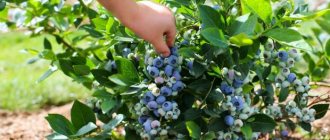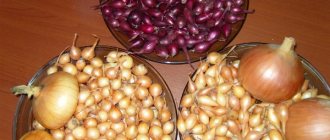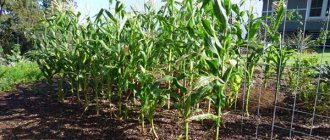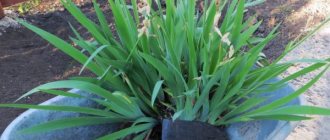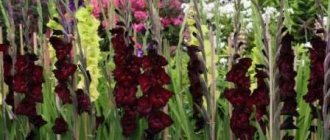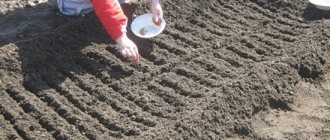What is the best way to plant raspberries?
There are different planting methods:
- seedlings;
- seeds;
- cuttings (green or woody);
- layering.
The best way to plant raspberries in spring for beginners is to use seedlings or cuttings. Both methods are quite simple and effective; the planting technology and timing are also approximately the same.
The first method is preferable - it provides the greatest survival rate. But seedlings are noticeably more expensive and more difficult to transport, so cuttings are used quite often. Let's look at the advantages and disadvantages of each of them in more detail.
Planting raspberry seedlings
A seedling is a full-fledged young plant that has already produced roots and is ready for further growth. Even a novice gardener will figure out how to plant raspberry seedlings in the spring without much difficulty. This approach is the most effective, reliable and convenient.
The main advantages of planting seedlings:
- maximum survival rate;
- there is no need to process cuttings and grow seedlings;
- no greenhouse needed;
- simplicity and minimum time costs.
This method is a priority because it has no disadvantages. The only reason to abandon this approach is the lack of seedlings.
Planting by cuttings
Raspberry cuttings
This is a complex and fussy method that requires experience and specific knowledge of how to properly work with planting material. But it is much easier to obtain and store cuttings than seedlings, and if you have good instructions, understanding this method is not so difficult.
The main advantage of planting by cuttings is the availability of planting material. Disadvantages include the need for specific treatment with various stimulants. For cuttings, you need to organize a greenhouse, and in the future you will have to replant the sprouted seedlings.
Attention! The most important factor for success is having a good pruning shears. The tool must be sharp and well assembled so that the cut is perfect and the handle is not crushed or injured.
Optimal time for planting
Early spring in the garden - time to plant raspberries
The most suitable time for planting is spring. Young cuttings take root especially well at this time; active sap flow leads to rapid growth of the rhizome. After the snow melts, the soil is saturated with moisture, which is sufficient for seedlings that do not waste resources on the growth of shoots .
It is recommended to start planting raspberries as soon as the snow has completely melted. This will give the bushes time to take root, begin to receive nutrients and strengthen the roots before the soil moisture decreases noticeably. Depending on the region and the length of winter, the optimal month may be March or April.
It is better to choose the time for planting when the snow has already melted, but the buds have not yet begun to bloom.
Often, planting raspberries in the spring for beginners is complicated by the fact that inexperienced gardeners want to wait until warm weather sets in. This is a big mistake, since the seedlings have too little time to strengthen the root system.
Temperatures rise and soil moisture drops sharply, making it much more difficult for tender roots to break through the soil. And there is not enough moisture necessary for growth.
Pros and cons of spring planting raspberries
Root system of raspberry cuttings
Spring is considered the best time to plant raspberries for a reason. This is a period of active growth and formation of the root system, accumulation of moisture and nutrients in the plant. Gardeners who know how to plant raspberry seedlings in the spring achieve the best survival rate of seedlings during this season.
The main advantages of spring planting:
- Over the winter, the soil has rested and been saturated with the minerals necessary for the young plant to quickly form roots and actively grow.
- The soil is saturated with melt water, which helps the seedling quickly grow young roots.
- The seedling has time to take root before the onset of heat and a significant decrease in soil moisture. Having developed a root system by the summer, the plant will be able to intensively grow shoots.
- In spring, many pests are still dormant because the soil is not warm enough.
To be fair, we note that autumn planting can also be the best choice in certain situations. This approach is good for remontant raspberries. In the fall, the plant has time to collect microelements and nutrients from the soil and strengthen the rhizome. In this case, it will overwinter well, and in the spring it will immediately begin to grow, without wasting time on root formation.
Soil preparation
In order for the plant to take root and develop normally, it is worth taking care of high-quality soil preparation. There are several basic nuances that need to be taken into account.
The step-by-step process for preparing soil for spring planting is as follows:
- The site for spring planting is prepared in the fall.
- In the autumn, the soil needs to be deeply loosened to enrich it with oxygen. Already in the spring you can dig up a bed with a spade.
- It is necessary to remove weeds from the soil along with their roots.
- It is worth adding ash, humus and manure to the soil.
Additional Information! To prevent the root system from spreading too much throughout the entire area, it is necessary to install limiters for each bush during the soil preparation process.
To do this, dig boards into the ground to a depth of 0.3 m along the perimeter of the bush planting.
Already in the spring you can add mineral fertilizers to the soil. It is not advisable to use nitrogen-containing ones, since such an aggressive substance can leave burns on the roots. Enrichment of the plant at this stage can be replaced by root feeding after planting, namely after 2-3 weeks.
Planting raspberries in spring - step-by-step instructions
To figure out how to plant raspberry seedlings in the spring, just study the simple step-by-step instructions. It is important to carry out all stages correctly, from the selection and preparation of seedlings, to the preparation of holes and the planting process itself. We must not forget about mineral fertilizers. Let's look at everything in order.
Selection and preparation of seedlings
Seedlings with a developed root system
The choice of planting material is the most important stage. It is necessary that the seedling is bushy enough and has a developed root. It is recommended to choose seedlings with 3-4 runs, 5-8 millimeters thick (more than 8 mm is undesirable).
The root should be moisturized and fresh in appearance, there should be no dry or brittle roots. A high-quality seedling has a developed fibrous root system up to 15 cm long.
It is also necessary to evaluate the condition of the kidneys. They should look fresh and not dry. If the buds are dry, such a plant is unlikely to be able to take root (even if the seller assures that he himself has planted such a hundred times). The buds should be fresh, maybe swollen, but not open.
If the seedlings already have opened buds, you need to carefully examine the emerging leaves. They should be juicy and have a distinct green color without yellowing. If the leaves are dull and yellowed, the plant is probably already infected with some kind of disease or parasites.
Landing place
Planted raspberry seedlings
To give raspberries the most comfortable conditions for growth, it is recommended to clear and prepare a good place in advance. It must be well lit and completely closed from the wind. Ideally, raspberry bushes should receive maximum solar heat after lunch, and before lunch they can be covered from the sun by a tree or building.
Keep in mind that raspberries always love fresh moisture, but prolonged stagnation of water is extremely undesirable for them. Therefore, the place for planting raspberries in open ground in the spring should be selected so that the groundwater is not very high.
It is undesirable to plant raspberries next to currants, which have developed roots and compete with raspberries in nutrients, greatly depleting the soil. But next to apple, pear and plum trees, raspberries feel good.
Distance between seedlings
The distance between seedlings is at least 50 cm
When planting, it is necessary to place the bushes so that the distance is at least 50 cm (it is important to take into account the characteristics of the variety, since the size of the bush can vary greatly). In the future, with such a distance, it will be possible to move freely between the bushes without trampling the roots or damaging the branches. This is important at all stages of cultivation, from loosening to harvesting. This distance is optimal given the size of the rhizome - individual bushes do not compete for nutrients in the soil.
Soil preparation
Loamy soil
Light soils and loams are best suited for raspberries. It is important that the soil is rich in minerals. Raspberries also grow on poor soils, but the harvest will be meager, so before planting it is necessary to thoroughly feed the soil. It is desirable that the medium be neutral or slightly acidic. If the soil is alkaline or highly acidified, the bushes will grow slowly, yielding virtually no harvest.
It is advisable to prepare soil for raspberries in the fall. It is necessary to remove all weeds and dig up the selected area, adding humus and ash in the process. Well-loosened and fertilized soil is leveled and left in this form for the winter.
Well preparation
Preparing the hole for planting
It will be much better if, instead of digging up the area, you prepare fertilized holes in the fall. Since raspberries have dense rhizomes, it is necessary to provide each bush with a sufficient volume of well-fertilized soil. Ideally, it is necessary to dig a round hole under each bush, the depth and diameter of which will be 50 cm.
Part of the soil removed from the hole is mixed with fertilizers, after which it is returned back to the hole (it must remain loosened; compacting is unacceptable) and left there for the winter. Young plants planted in the spring will quickly grow large roots that fill the entire hole.
The best fertilizers for raspberries
Fertilizer application
As soon as the hole is dug, you need to pour 4 kilograms of compost into the very bottom and distribute it evenly. And the rest of the organic and inorganic fertilizers should be mixed into the soil removed from the hole.
For one hole, the following quantities of different fertilizers are recommended:
- superphosphate – 50 g;
- wood ash – 1 cup;
- nitrogen fertilizers – 30-50 g;
- rotted manure – 3 kg.
Even if the soil is fertile, fertilizing cannot be neglected, otherwise the harvest will be poor.
Landing
Trench planting method
Let’s immediately make a reservation that there are two generally accepted methods of planting raspberries in open ground in the spring: bush and trench. Both have both pros and cons.
Let's look at each of them in more detail:
The bush method of planting raspberries is good because it allows you to do without preliminary preparation of the soil and hole in the fall. A separate hole, approximately 50 cm deep and wide, is dug for each bush. Part of the soil (preferably the top) is mixed with fertilizers and placed back into the hole. As the hole fills with soil, the seedling is placed in it. It is held so that all parts of the rhizome are fluffed up and not pressed down by the ground, but are evenly distributed in the space of the hole.
During the process, you can carefully lift the seedling up so that the soil fills the voids under the roots. When the hole is filled, the earth can be lightly compacted.
The trench method is used when growing raspberries on an industrial scale, but it can also be found quite often on private plots. The site is usually prepared in advance. Next, the required number of trenches with a depth of 50 cm and a width of 50-60 cm are dug on it at intervals of 1-1.5 meters.
Do not forget that raspberries do not like prolonged stagnation of water. If the site is characterized by high groundwater levels, it is recommended to lay drainage at the bottom of the trench. And on top of it you can already pour a mixture of soil, mineral and organic fertilizers.
The distance between seedlings during trench planting is about 40 cm. When planting, the trench is filled with soil mixture, and seedlings are placed in the center. It is important to choose the right level so that part of the rhizome does not end up outside, but the stems do not go too deep underground.
Planting remontant raspberries
Remontant raspberry varieties are those that manage to bear fruit twice per season. Usually the first harvest is harvested at the beginning of summer, the second at the end. Moreover, the second time the plant bears fruit much more abundantly, and the berries themselves are larger and sweeter. But growing remontant raspberries is somewhat more difficult due to their capriciousness.
When planting such varieties, it is important to ensure that the following conditions are met:
- more careful care is required (watering, loosening the soil);
- bushes should be well lit;
- drafts and cold wind are unacceptable;
- the soil should be as fertile as possible and rich in all necessary minerals.
It is recommended to plant remontant raspberries on the south side of the site, so that no obstacles block its sunlight. At the same time, it must be protected from winds and drafts on all sides. Since remontant raspberries produce significantly more yield than other varieties, the soil should be as fertile as possible.
It is also important to ensure that it is always moist and loosened so that there is air access. It is strictly forbidden to compact the soil, since with a lack of air, water or nutrients, plants of remontant varieties die very quickly. With proper care, you can harvest two abundant harvests of large and very tasty berries from each bush in one season.
Trimming
Pruning and shaping of raspberries is carried out after the soil has dried and constant above-zero temperatures have been established. As a rule, it is done in two stages:
First stage
Excessive shoots, old, diseased, fruit-bearing and pest-infested stems are cut out at the root. With the bush growing method, 6-8 shoots are left per bush. With trench 15-20 per linear meter.
It is important to prevent plantings from becoming too dense, as this leads to crushing of the fruits and a significant reduction in yield.
Second phase
Performed when stable positive temperatures are established, not lower than +5. During this period, the results of wintering are clearly visible, the buds have opened, the tops have begun to grow.
Healthy shoots are shortened by 20 cm to form side branches for additional fruiting; frozen and dried shoots are shortened to a living bud.
Pruning in spring helps to lengthen the fruiting period and lay a more abundant harvest. For this purpose, the shoots are divided into 4 parts:
- For fruiting at the beginning of the season, they are shortened by 10-15 cm.
- The second part is cut to 20-30 cm.
- For the third wave of harvest, the shoots are shortened by half.
- The fourth part is shortened to 3 cm above the ground level; this will be the last, latest fruiting.
More on the topic: Separate cultivation of raspberries according to Arkhangelsky with pruning according to Sobolev
Caring for raspberries after planting
Well-groomed seedlings of remontant raspberries
Immediately after planting, the bushes need special care, since the rooting period is the most critical. Typically, caring for raspberries in the first year of life includes the following steps:
- The soil around the seedling is slightly deepened, forming a hole for watering.
- It is advisable to mulch the soil in a timely manner, sprinkling it with chopped straw, shavings or sawdust. Mulching will protect the soil from drying out, and if the soil is covered, weeds will germinate in smaller quantities.
- The cuttings are cut so that 25-45 cm remain, and it is important to ensure that there are unblown buds on it.
- Before rooting, plants do not require too frequent watering, and if spring rains occur frequently, then you can do without watering at all.
- In the first year, the plants are not fed, since the fertilizers that were added to the hole during planting are sufficient for them.
As you can see, caring for raspberries after planting involves simple steps and does not require much effort. But carefully following all the steps will make the plants stronger and the harvests more abundant.
Planting raspberry seedlings in spring in the Urals
Thus, raspberry seedlings are planted in the spring in the Urals much later than in regions with a warmer climate. Here, the most suitable time for planting is the end of spring, and sometimes even the beginning of summer.
Many raspberry varieties are not intended for cultivation in the Urals, since the warm part of the year is quite short here. In particular, remontant varieties, which require plenty of warmth and sunny days, as well as a long summer, are not suitable for this region.
Otherwise, when planting raspberry seedlings in the spring in the Urals, you need to adhere to the same rules as usual. Raspberry seedlings tolerate frost well, especially for frost-resistant varieties adapted to the local climate.
Raspberry varieties
There are regular and remontant varieties of raspberries, each of which is adapted for its own climatic zone. For example, Polish Polka and Benefis are well suited for the European region, and Baltic Viktorija and Ina are suitable for mild climates with cool, humid summers. Among the varieties of Russian selection, the large-fruited and frost-resistant Hercules, Yellow Giant and Apricot are popular.
There are also universal varieties that can grow in most regions: Novosti Kuzmina, Meteor, Octavia, Vera, Marlboro and others.
When choosing raspberries for your plot, pay attention to their resistance to frost and drought, ripening time and taste of the fruit. Read more about the varieties of berries in the article about raspberry varieties.
Planting raspberry seedlings in spring in Siberia
This region is characterized by a pronounced continental climate, which significantly affects the routine of local gardeners. Even after warming, severe cold often returns here.
Therefore, planting raspberry seedlings in spring in Siberia should be planned in advance, taking into account the weather forecast. Here, too, not all varieties can be grown, but only those that tolerate cold weather well.
There are many varieties that are suitable for growing in the Siberian climate (the most famous of them is “Gift of Siberia”). It’s not worth growing remontant raspberries here; they still won’t be able to bear fruit twice. And if it accidentally blooms a second time, the berries most likely will not have time to ripen. Planting raspberry seedlings in spring in Siberia is carried out according to the usual rules, and it is imperative to choose areas that receive the greatest amount of sunlight.
Common mistakes when planting in spring
It is important to consider that planting raspberries in the spring for beginners is fraught with some typical mistakes that inexperienced gardeners make. It is better to remember them immediately so as not to commit them in the future.
So, in order for the raspberry bushes to turn out lush and the harvests to be generous, the following mistakes must be avoided:
- Ignoring defects, traces of diseases and parasites on cuttings.
- Plant next to competing crops, under trees or in the shade of buildings.
- Planting in unsuitable types of soil (clay and heavy soils are not suitable at all, alkaline and strongly acidic environments are also not suitable).
- Planting new seedlings in an old place without intermediate cultivation of green manure, which enriches the soil with nitrogen and other microelements.
- Improper pruning, leading to depletion of the plant due to an excess of useless shoots.
- Excessive deepening of the seedling. If the neck of the seedling ends up in the ground, the stem may rot in the future.
As you can see, there are not many rules, and it will not be difficult to follow them. But the reward for your efforts will be abundant harvests of tasty and aromatic berries. And if you successfully select several different varieties, you can enjoy ripe and fresh raspberries almost all summer and autumn.
Best place to grow
Raspberries, like many other plants, are very demanding of sunlight. With a lack of light, raspberry shoots become very elongated and become less protected from pests and severe winter frosts. The yield of such plantings is low.
Attention! Remontant raspberries are particularly demanding of sunlight; ordinary varieties can be grown in partial shade, along fences and walls of premises.
When planting, it is recommended to place rows of plants from south to north.
When choosing a place to grow raspberries, it is also worth considering the movement of winds, since drafts negatively affect the volume of fruiting and the growth of the crop as a whole. It is also not recommended to plant the crop in lowlands and wetlands. Increased soil moisture slows down the growth of raspberries and makes the berries small and lacking the characteristic taste qualities of the variety.

